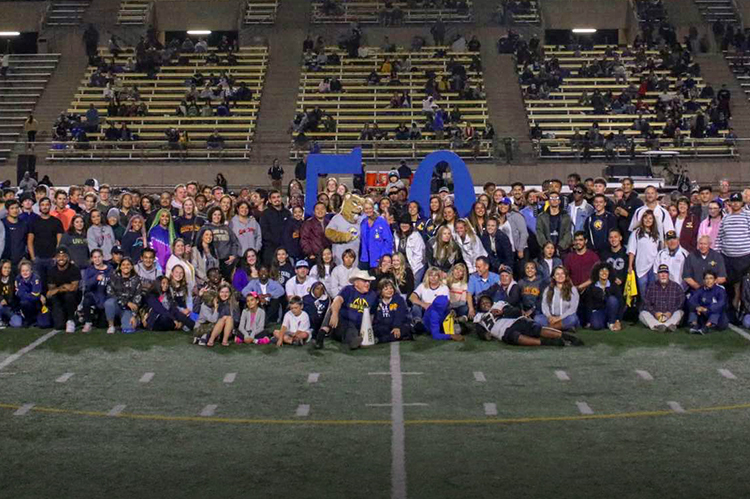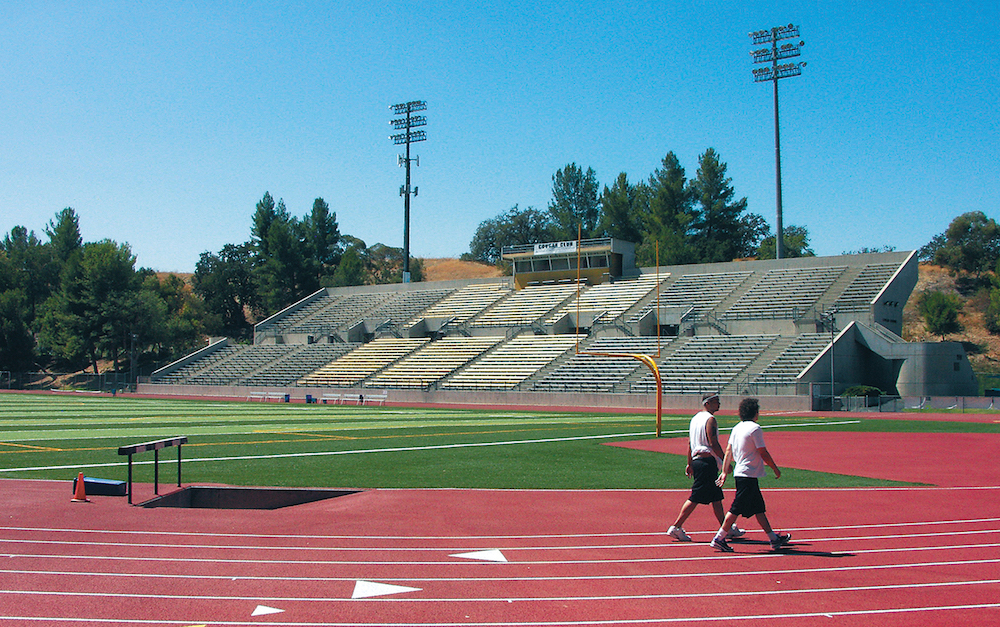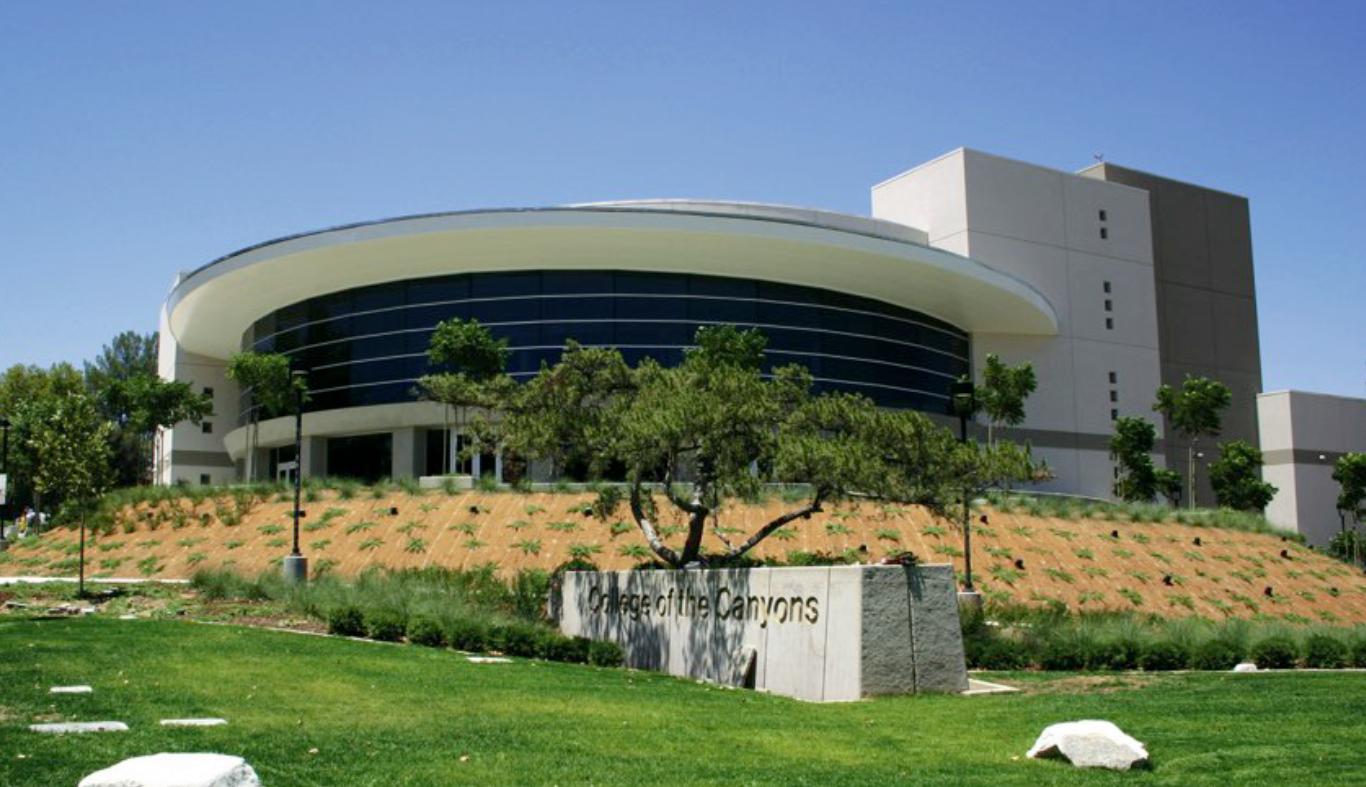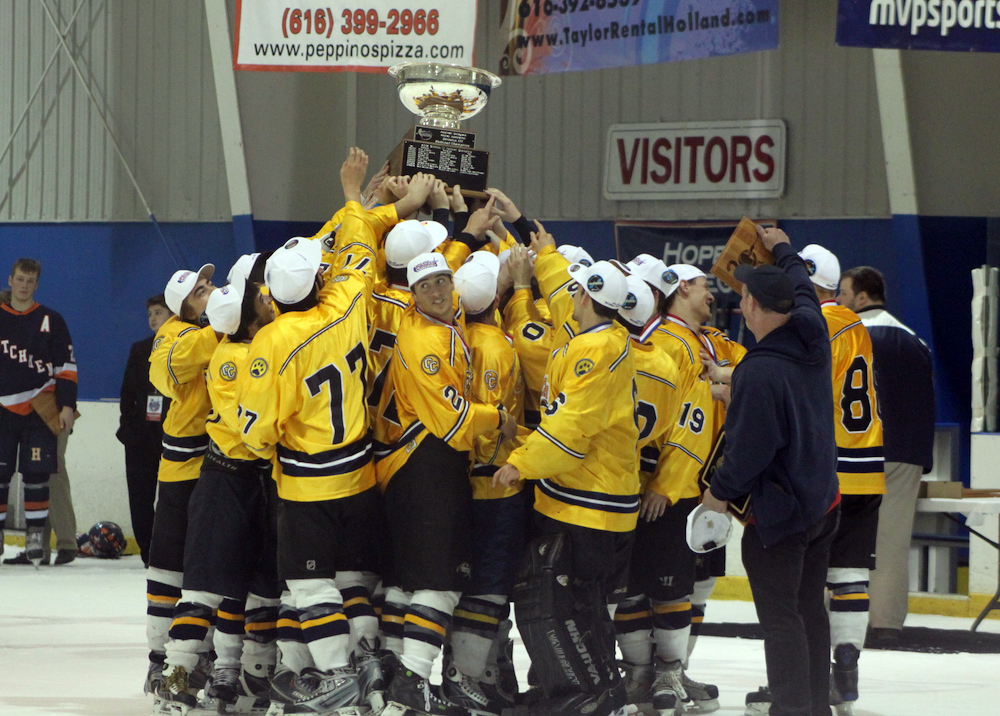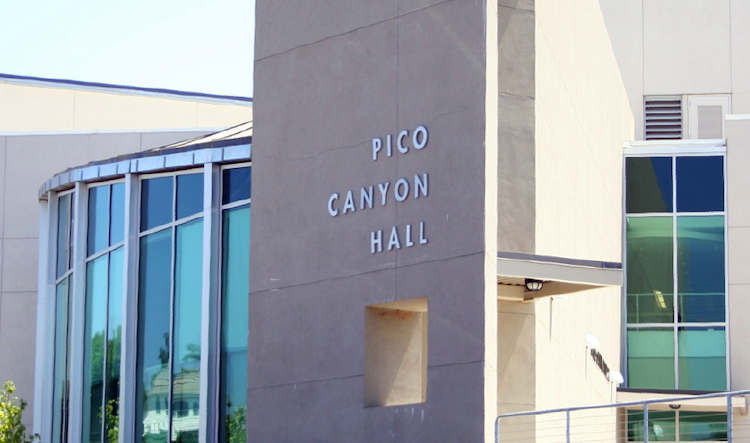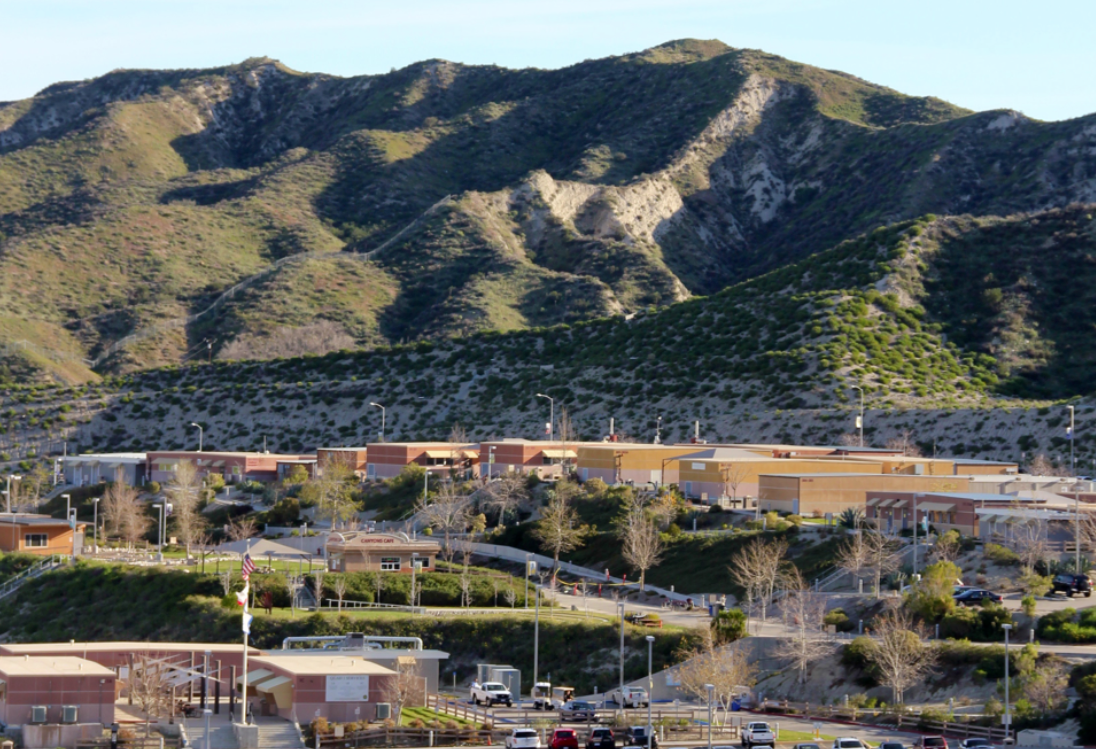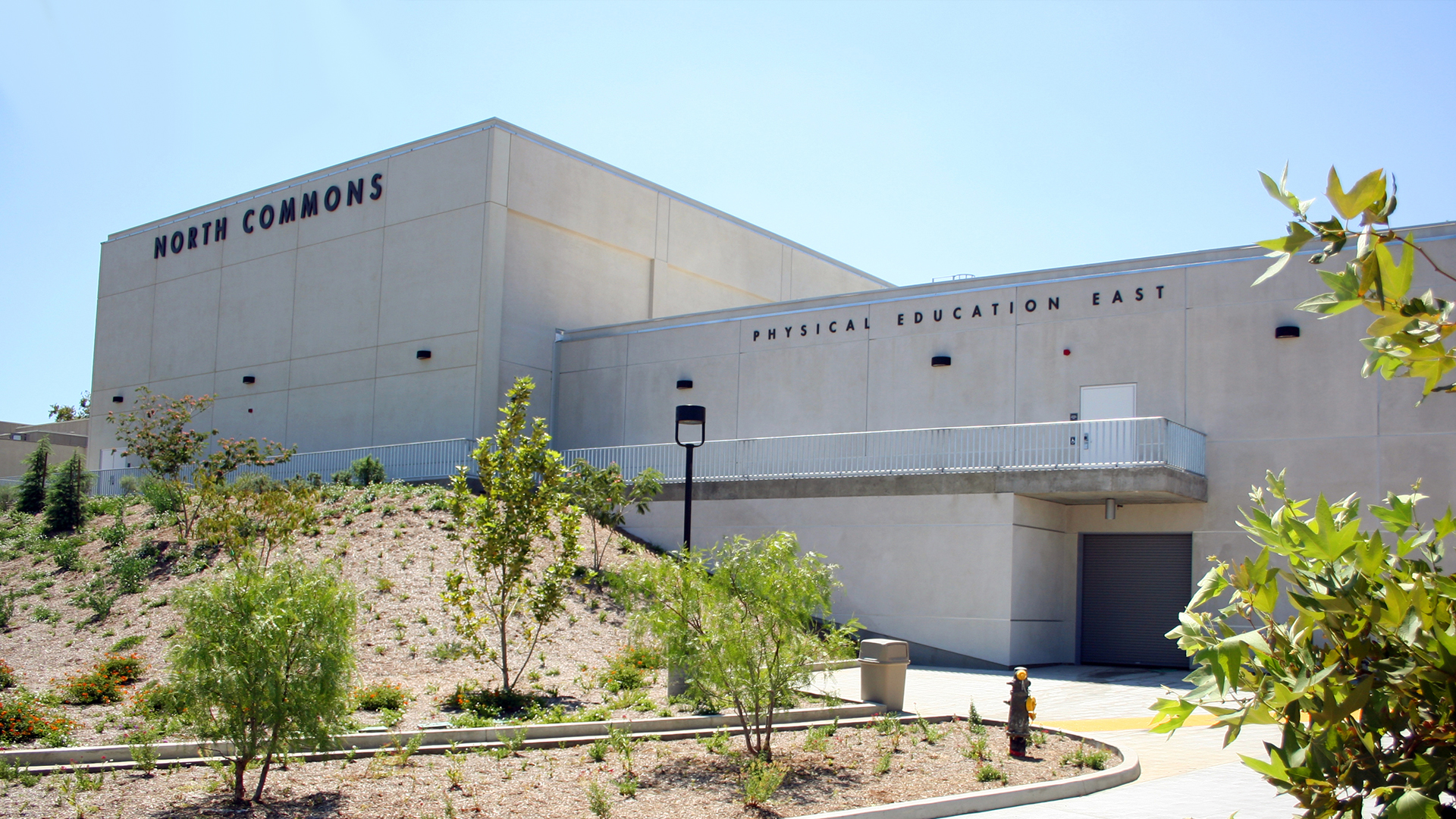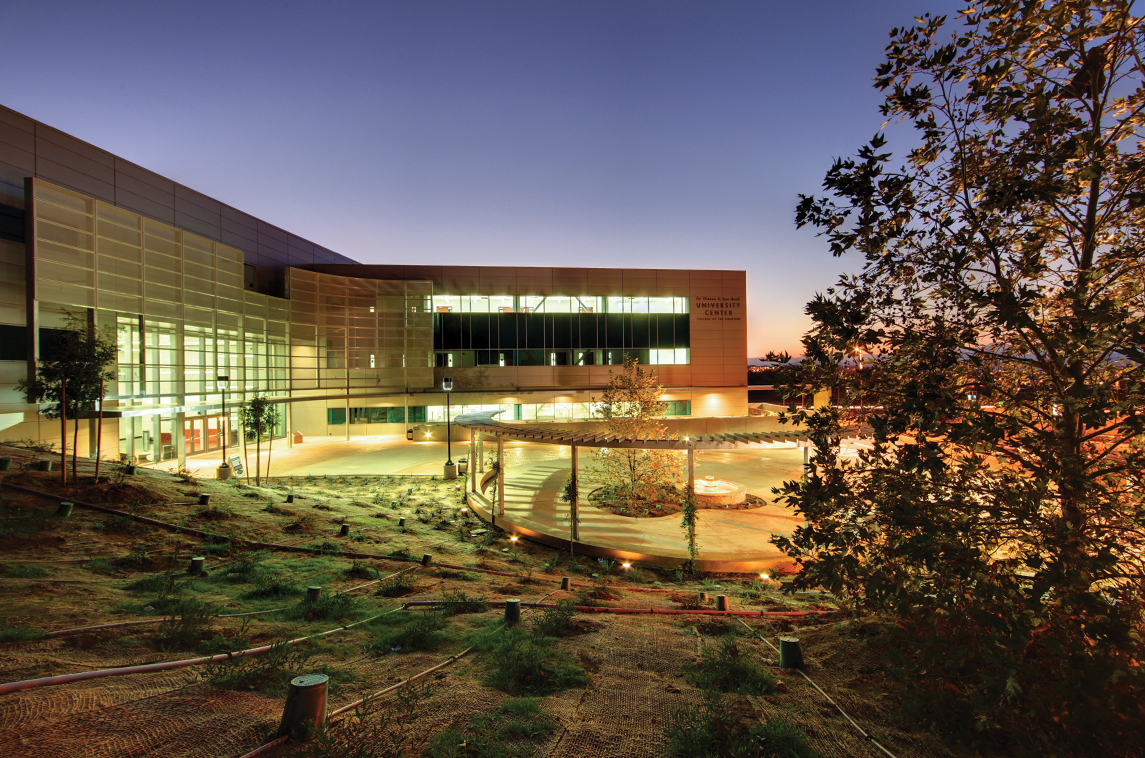50th Anniversary
Part 3
Part 1 | Part 2 | Part 3 | Part 4
Bold Steps Forward
A historic day arrived at Academy of the Canyons on June 10, 2001, when the very first class of 55 students graduated. History was made in the college's board room as well, when the trustees supported Van Hook's request to present an $82.1 million bond measure to voters that would address the college's limitations in the face of unprecedented enrollment growth. The bond measure, to be called Measure C on that November's ballot, would help finance a variety of new buildings, expansion projects and facility improvements.
 Student enrollment that fall of 2001 grew yet again, rising 18 percent over the previous year, as 12,851 students registered for classes.
Student enrollment that fall of 2001 grew yet again, rising 18 percent over the previous year, as 12,851 students registered for classes.
Excitement continued to build for the planned University Center, which would need a permanent facility to house the university degree programs. College faculty and staff, as well as community leaders, came together in late August to launch the project's capital campaign. Not surprisingly, 99 percent of the college's personnel pledged financial contributions to get the campaign rolling.
The college also created a more significant presence in the eastern Santa Clarita Valley, opening its ACCESS learning center - featuring several classrooms and a computer lab - inside the then-new Jo Anne Darcy Canyon Country Library complex. The move was one of the first tangible inroads into an area of the valley that was home to some 32 percent of the college's students. College leaders understood that this area would require even more attention in the future. It was here that the college was laying the groundwork to acquire property and build a second campus.
Sept. 11, 2001 was an ominous day for the nation. The terrorist attacks of that morning stunned the world. Hundreds of students, faculty and staff members converged around a half-risen American flag during a Sept. 14 vigil to honor the victims. Many in the hushed, somber crowd wept openly.
With the pall of 911 still very much a part of the public psyche, voters decided that College of the Canyons should move forward in a bold and dramatic way. On Nov. 6, an overwhelming 68 percent of local voters approved Measure C, the $82.1 million general-obligation bond measure to renovate facilities and build new ones. As if that resounding message from the populace wasn't optimistic enough, the year came to a close with the December groundbreaking ceremony for a most-anticipated and high-profile building designed for both the college and the community: the Performing Arts Center.
Interim University Center
Continuing the practice of meeting the community's needs in a quick, responsive manner, the college built the Interim University Center on the south side of campus. When it opened on Jan. 22, 2002, seven educational institutions were already signed up to offer a variety of programs leading to bachelor's and master's degrees.
A week later, The Signal honored Van Hook as Newsmaker of the Year for 2001. The award recognized her efforts to move the college forward in significant and dramatic ways, culminating with the community's approval of Measure C, which would allow that momentum to continue.
Facilities expansion continued in 2002. Work began in the fall on the Vocational Technology Center to add 3,500 square feet of space to accommodate new manufacturing technology classes and nearly $200,000 worth of new equipment.
In a state experiencing an acute shortage of nurses, College of the Canyons also was emerging as a leader in nursing education. In September, the College of the Canyons Clinical Education Center opened its doors at Henry Mayo Newhall Memorial Hospital. The center represented a unique cooperative effort between the college and the hospital to help alleviate the nurse shortage. Then, in early 2003, the college took the lead with the new Associate Degree Nursing Regional Collaborative, an innovative partnership among the region's hospitals and community colleges to produce even more qualified nurses.
Cougar Stadium received upgrades in the form of artificial turf and new running track in 2003.
Accreditation Renewed
The Western Association of Schools and Colleges was so impressed with College of the Canyons that it granted unconditional reaccreditation for the maximum-allowable six-year term in early 2003. The University Center capital campaign made strides as well, reaching a pledge total of $4.1 million in February. The campaign was well on its way raising $10 million for a permanent home on the southern edge of the campus.
Athletic accomplishments figured prominently in 2003. In May, the men's golf team won its third state championship. In June, a $1 million renovation of Cougar Stadium was unveiled to the public, revealing a state-of-the-art synthetic-grass playing field and new running track. Also that summer, men's soccer was added to the roster of intercollegiate sports. Perhaps most impressive of all, the football team recorded its first perfect regular season with 10 straight victories, as well as a victory in the WSC Bowl.
For most students, it just wouldn't be College of the Canyons without the constant clatter of construction activity. Sure enough, 2004 was punctuated by more of it. Construction began on the 20,000-square-foot Music-Dance Building (later renamed Pico Canyon Hall), a $7 million Measure C-funded project adjacent to the Performing Arts Center, which itself was under construction. The road that serves as the main entrance off Rockwell Canyon Road was reconfigured to incorporate a circular pattern for pick-ups and drop-offs. Three lighted electronic message boards were installed along Rockwell and Valencia Boulevard. In a portent to the inevitable construction to come, the University Center capital campaign hit the $7 million fundraising mark, and the state gave the college the green light to move forward with plans to acquire land in Canyon Country on which to build a second campus.
The Performing Arts Center was ready for its close-up on opening night Oct. 15, 2004.
Performing Arts in Spotlight
The big news of 2004 was the opening of the $18.3 million Performing Arts Center. The community welcomed the long-awaited center, which would now fulfill the dual role of serving as both a performance venue for the college's performing arts programs and the valley's independent arts groups. The gleaming, glass-encircled lobby bustled with activity as a grand-opening ceremony marked the occasion on Oct. 15. Patrons packed the two-level proscenium theater to experience a sold-out production of "Big River," which showcased the combined talents of the college's theatre, music and dance departments. The inaugural season at the center, which also houses the more intimate Black Box Theater, featured a variety of college, community and professional productions, including Paul Anka, Melissa Manchester and the Vienna Boys Choir.
The commencement ceremony on May 21, 2004 was notable not just for the nearly 1,000 students - 997, to be precise - who graduated, but because the number of graduates rose a whopping 27 percent over 2003.
A series of fierce, devastating wildfires struck the region in the summer of 2004. Although the college was not directly threatened, it played a crucial role. Los Angeles County set up its Emergency Command Center at the college in mid-July. Buildings, parking lots and playing fields were inundated with firefighting vehicles and equipment, as well as tents and facilities for firefighting personnel from throughout California and several western states. The American Red Cross also utilized the campus, housing and feeding evacuees.
Second Campus is Born
The college took a major step forward in 2004 with ambitious plans to expand its presence in the eastern Santa Clarita Valley. Most significantly, the California Community Colleges Board of Governors and California Postsecondary Education Commission gave the go-ahead to build the Canyon Country Education Center, a then-50,000-square-foot facility that would eventually become the college's second campus.
The college's fledgling hockey team skated to a state title in 2004.
Once again, the college's athletic achievements were impressive. The college's fledgling club hockey team won the state title during the 2004 Pacific Collegiate Hockey Association State Championship, beating teams from universities such as UC Davis, San Diego State, UC San Diego and UC Irvine. Three Cougar pitchers were chosen in the 2004 Major League Baseball Draft to play for the Kansas City Royals, Pittsburgh Pirates and San Francisco Giants. The NFL came calling for three former Cougars, signing them to play for the San Francisco 49ers, Jacksonville Jaguars and Cincinnati Bengals. In October, the Carolina Panthers signed former Cougar wide receiver Jamall Broussard. And, the football team eclipsed its astounding 2003 season by racking up a perfect 14-0 season and beating top-rated City College of San Francisco to capture the state championship. The team also was named the top community college football team in the nation.
The college and its leadership continued blazing new trails in 2005. The year began on a promising note, as the first class of 103 nursing students began instruction Jan. 4 under the auspices of the Southern California Associate Degree Nursing Regional Collaborative, a college-hospital partnership designed to help alleviate the nursing shortage.
Construction continued its hectic pace. Ground was broken May 5, 2005 for the new High Technology Building (later renamed Hasley Hall), a 34,000-square-foot complex of classrooms, labs and offices that would be nestled between the Student Center and Physical Education Center.
The college graduated its largest class yet - 1,153 students - during the commencement ceremony on May 20, 2005. The size of the graduating class was nearly 16 percent larger than the previous year.
Top Transfer Rate
Solidifying its position as one of the top feeder schools to California's public universities, College of the Canyons recorded the highest transfer rates to the University of California and California State University systems of all community colleges in Los Angeles County. A report by The National Center for Public Policy and Higher Education showed the rate of transfers at College of the Canyons was the highest of the 21 colleges in the county, and was in the top 14.5 percent of California's community colleges.
Pico Canyon Hall, devoted to music and dance, opened in the fall of 2005.
The state-of-the-art Music/Dance Building (later renamed Pico Canyon Hall) opened in the fall of 2005 with an open house that showcased the $8.5 million facility's dance and music spaces. Later that year, the much-anticipated groundbreaking for the ambitious science expansion project occurred. The Oct. 20, 2005 ceremony marked the official start of construction on 32,404 square feet of classrooms, labs and lecture halls that would ultimately create two state-of-the-art facilities: Aliso Hall and Aliso Labs. The buildings would provide additional laboratory and classroom space for biology, chemistry, engineering, physics, astronomy and nursing programs. The $18.7 million project was partially funded by bond proceeds from Measure C.
The college ended the year on a typically positive note, holding yet another groundbreaking ceremony, this time for one of the most significant projects to date: a second campus in Canyon Country. Years of planning had produced a centrally located 70-acre parcel along Sierra Highway that would provide convenient access to students in the eastern Santa Clarita Valley. The Dec. 6, 2005 event marked the opening of a new chapter that would significantly enhance access to higher education.
New Training Programs
The introduction of new, in-demand degree and training programs continued. First was the culinary arts program that debuted in early 2006, offering students its first class in fundamental techniques for commercial kitchen operations. Then there was the introduction of the automotive technology program, a result of the college's strategic partnership with the Santa Clarita Valley Auto Dealers Association and the William S. Hart Union High School District. Funded in part by a state grant, the program was launched at Saugus High School to address a critical shortage of qualified automotive technicians. And, the college launched new programs in construction management and land surveying to meet increasing demands for trained workers in the construction and surveying industries.
The college's athletic programs earned several key distinctions in 2006. The club hockey team continued to impress. The 2004 state champions earned a berth at the national championship games in Fort Myers, Fla., once again becoming the only community college team to receive such an invitation. Then, Howard Fisher, the men's basketball coach, was chosen to serve as head coach of Team USA for the Maccabi Australia International Games in Sydney, Australia. He and his team returned home after earning a bronze medal with a victory over Australia.
The 2006 commencement ceremony saw 1,182 students graduate, a 2.5 percent increase over the previous year. With the student population increasing with every passing year, demand for educational programs - and the facilities to house them - continued its rapid pace. Construction began yet again on a new, much-needed facility, this one a 21,543-square-foot structure housing another gymnasium, locker rooms and an assortment of classrooms and faculty offices. The project also included another first for the college in the form of six outdoor tennis courts. The $6.4 million project was funded by a combination of state dollars and proceeds from Measure C.
Aliso Hall, a new building dedicated to the sciences, opened in 2007, as did the adjacent Aliso Labs and nearby Hasley Hall.
Community Renews Support
Five years after the passage of Measure C, the $82.1 million bond measure that was used to provide a variety of new facilities and campus upgrades, the need for further expansion became abundantly clear. The Board of Trustees once again turned to the community for support and placed a new, $160 million bond measure on the Nov. 7, 2006 ballot. Voters responded to the Measure M proposal with a resounding level of support, signaling the start of another round of expansion and modernization projects, as well as construction of facilities at the soon-to-open Canyon Country campus. Measure M was the second bond measure of the decade and the fourth in the college's history.
The year 2007 was one that saw significant and tangible results of the college's planning for the future. First up was the March 16 groundbreaking ceremony for the permanent University Center, a $36 million, 110,000-square-foot facility that would house degree, credential and certificate programs from a variety of public and private universities. Shortly afterward, on May 3, the Board of Trustees voted unanimously to name the building after Superintendent-President Dr. Dianne G. Van Hook because of her "tireless commitment to enhancing access to education, her belief in the power of dreaming big and never giving up, and her premise that we, as individuals and institutions, become what we give ourselves the power to be."
Next was the July 11 ribbon-cutting ceremony that marked the opening of two new science buildings: Aliso Hall and Aliso Labs, located adjacent to the existing science building, Boykin Hall. With a combined 32,404 square feet, the new buildings provided a considerable expansion of academic and training programs in the sciences.
The Canyon Country campus opened Aug. 27, 2007.
New Campus Opens
On Aug. 28, a ribbon-cutting ceremony was held at the district's brand-new 70-acre campus in Canyon Country. Featuring 23 classrooms and five laboratories in approximately 24,000 square feet of instructional space, the new campus officially opened its doors on Aug. 27, 2007 to more than 3,000 enrolled students, surpassing all projections. Thousands of community members descended on the new campus for an opening celebration on Oct. 6, 2007. As if this wasn't enough, one final ribbon-cutting ceremony of the year took place toward year's end, this one for Hasley Hall. The high-tech classroom building officially opened on Nov. 28, 2007.
The U.S. Department of Education held hearings at the college on March 5, 2007 as part of a congressionally requested study to make college textbooks more affordable. This was followed shortly afterward by a visit from U.S. Secretary of Education Margaret Spellings and U.S. Rep. Howard "Buck" McKeon to get a closer look at the University Center. Specifically, they gathered "best practices" that had the potential of being replicated across the country.
The Performing Arts Center's name was modified in mid-2007 to better reflect its role supporting performing arts throughout the community. The newly named Santa Clarita Performing Arts Center at College of the Canyons reflected its emergence as a focal point for both city and college arts and entertainment.
The commencement ceremony on June 1, 2007 saw another huge turnout, as 1,147 students graduated. New or expanded educational programs continued to be introduced. The college moved closer to launching its planned medical lab technician (MLT) training program to address a critical workforce shortage.
Following the early success of the land surveying and construction management programs the previous year, the college added another related program, this one in building inspection. And, the Foreign Language Department added Mandarin Chinese for the first time.
The college's pivotal role in providing cutting-edge workforce training throughout the community and region was recognized by the federal government when, on Jan. 4, 2008, Sandy Baruah, assistant secretary of commerce for economic development, joined local officials to present the college a $1.3 million grant to develop an emerging technologies training program, the only such program in Southern California to train workers for the biotechnology, nanotechnology and autonomous technology fields.
Clear Vision of Future
As mid-2008 approached, Superintendent-President Dr. Dianne G. Van Hook could look back at 20 successful years at the college's helm. The Board of Trustees marked her 20th anniversary by giving her a new title: Chancellor, Santa Clarita Community College District, and President, College of the Canyons. "I am proud and so glad that our board had the courage to hire Dianne, and I am thrilled about the leadership she has provided over the years," said Board of Trustees member Michele Jenkins, who was on the board that hired Van Hook in 1988. "Her many strengths in fundraising, creating and maintaining partnerships, her clear vision of the future, as well as her uncanny ability to hire outstanding people have helped make COC what it is today."
Commencement 2008 saw the largest graduating class yet at 1,255 students, a 9.4 percent increase over the number of graduates just a year earlier.
The Physical Education East building opened as part of an athletic facility expansion in 2008.
Continuing down the road of campus expansion, yet another ribbon-cutting ceremony occurred. The Sept. 11, 2008 event marked the official opening of the new physical education building and six tennis courts designed for intercollegiate play. The $10 million, 21,543-square-foot facility would accommodate new athletic curriculum and intercollegiate sports programs. When the original physical education facility opened in the 1970s, it was part of a campus originally designed to serve 5,000 students. By late 2008, enrollment was more than four times that figure, surpassing 22,000.
In early 2009, the college received the highest possible accreditation rating from the Western Association of Schools and Colleges. The commission commended the college for its strong commitment to: student success, collaborative governance, the fostering of numerous community partnerships, the use of data-driven planning and evaluation processes, technology use including student and faculty training and support, the provision of a wide array of student support services, and the presence of professional development opportunities for faculty and staff.
Chancellor Van Hook was named Woman of the Year by the Los Angeles County Board of Supervisors and Commission for Women on March 16, 2009. Aside from serving as role models, nominees must have worked on behalf of women's issues and made significant contributions to women's equality. "I'm passionate about California community colleges and the opportunities they afford people to become whomever they want to be," Van Hook said. "I have been blessed to be able to work in this amazing system of education and to build bridges for people so they can open doors and realize that they can succeed. What an honor it is to be recognized for my decades of commitment to enhancing opportunities for women - one person at a time."
New Programs Debut
The college continued to introduce new, in-demand educational and training programs. One such program was the Fast-Track Paramedic-to-RN program, providing a potential solution to California's statewide nursing shortage by fast-tracking qualified students through the process needed to obtain licensing as a registered nurse in as little as 15 months. And, the state awarded the college a $400,000 grant to help fund the medical lab technician (MLT) program.
It was another big year for facility expansion. Construction officially began on Sept. 10, 2009 on a $10.7 million, 32,040-square-foot expansion of Mentry Hall. Funded by proceeds from the voter-approved Measure M bond measure, the project added 16 classrooms, 12 offices and two conference rooms.
The Canyon Country campus got in on the expansion fever, holding a ribbon-cutting ceremony for its new 2,150-square-foot Center for Early Childhood Education on Sept. 17, 2009. And, the Emerging Technologies Instrumentation Laboratory and Cleanroom opened to prepare students for the nanoscience and nanotechnology fields.
The University Center increased opportunities for residents to earn advanced degrees from a variety of public and private universities without leaving the Santa Clarita Valley.
University Center Opens
The year's biggest opening, by far, was for the Dr. Dianne G. Van Hook University Center, whose ceremonial ribbon was cut Oct. 17, 2009. Hailed as a solution to the lack of upper-division, graduate-school and continuing educations programs in the area, the University Center was created to increase student access to advanced degrees by forging partnerships with four-year universities, which offer their programs locally. The facility also became home to the William S. Hart Union High School District's award-winning Academy of the Canyons and the college's Economic Development Division, among others.
With California still mired in a lingering recession, College of the Canyons continued to play a pivotal role in jump-starting the region's economy and getting people back to work. The economic recovery efforts focused on providing support for entrepreneurs and technology startups, providing fast-track training for in-demand fields, and providing educational and training programs in the most-promising emerging fields.
Workforce Training
The college's Economic Development Division launched a new initiative to help the unemployed train and launch new careers. The Fast Track Institute began offering 18 fast-paced, intensive job-preparation programs in manufacturing, green technology, medical/general office, and managerial/professional. The programs allowed participants to quickly begin working in industries needing skilled workers.
The college received a four-year, $3 million grant from the National Science Foundation to establish the California Regional Consortium for Engineering Advances in Technical Education (CREATE) Renewable Energy Regional Center, and to lead 13 colleges and universities in creating and expanding courses and workforce training programs in California.
Also introduced in 2010 was the medical lab technician training program, which was created specifically to address the shortage of trained personnel needed by the growing biotechnology industry.
Students returning to the Valencia campus for the start of the fall 2010 semester were welcomed by a dramatically expanded Mentry Hall, which grew by 32,040 square feet. Funded by Measure M and completed over the summer, the $10.7 million expansion project added two computer labs, a large lecture room, 11 classrooms, a 2-D drawing classroom, a life/drawing classroom, two conference rooms and 12 offices to the original building, increasing the building's overall size to 76,339 square feet.
The year also saw the college's popular culinary arts program relocate yet again, this time from its temporary Town Center Drive location to a former restaurant in Castaic. Without adequate culinary facilities at either campus, the seemingly vagabond program settled into its new home, removed yet again from the campus environment and underscoring the need for a permanent facility.
Library/TLC Expansion
Before the year was out, the college embarked on yet another ambitious expansion project, this one focused on the now-outdated Valencia campus Library. A groundbreaking was held on Nov. 16, 2010 for a $16 million expansion project that would add some 51,000 square feet of space, and usher in a thoroughly revamped and expanded TLC (The Learning Center), which would share some of the Library's new space.
The start of 2011 marked the end of a significant chapter in the college's history. The books were officially closed on Measure C less than 10 years after it was approved by voters. By any standard, the $82.1 million general obligation bond measure was a success in all respects. It was responsible for more than doubling the square footage of educational facilities on the Valencia campus, and it funded the purchase of land on which an entirely new campus was built in Canyon Country. Beyond the amount approved by voters, an additional $7.8 million came from interest and refunding of bond proceeds, which enabled the college to acquire $40.5 million in matching funds from the state.
Four years after opening, the Canyon Country campus continued to expand, this time with its first permanent building, the Applied Technology Education Center. The center officially opened on Aug. 25, 2011.
It was also another big year for college athletics. The Athletic Hall of Fame boosted its ranks with the induction of the Class of 2011. Among the honorees were the 1993 state championship men's golf team, former women's basketball player Kyetra Brown, former football player Mike Herrington, former women's soccer player Kristine Marbach, and former football player Isaac Sopoaga. And, although not recognized as an intercollegiate sport in California's community colleges, the ice hockey team demonstrated it was a force to be reckoned with, coming from behind to beat Hope College on March 12, 2011 to win the American Collegiate Hockey Association Division III National Championship.
The college continued to do its part to help stimulate the economy by forging new relationships and strengthening existing ones by offering new or expanded training programs and utilizing its resources to best serve business and industry. The California Community Colleges Chancellor's Office approved a plan that allowed the college to establish a Center for International Trade Development. Operated in collaboration with the Small Business Development Center, the new venture provided resources, training, and expert business advice and consulting in international trade.
The TLC expanded dramatically, growing from 5,000 to 41,000 square feet devoted to learning.
A dramatically expanded Library opened, as did the impressive new home for the TLC, whose space soared from 5,000 to 41,000 square feet. A ribbon-cutting ceremony on Oct. 24, 2012 officially unveiled the new Library and TLC, which together provided students with more than 52,000 square feet of new classrooms, study spaces and tutoring facilities.
Campus Milestone
The Canyon Country campus celebrated a milestone by marking its fifth anniversary with a community open house. Enrollment at the college's second campus continued to climb at an unprecedented rate, topping 5,000 students within its first five years.
As 2012 drew to a close, it was time to bid farewell to the "A Building," as the outdated facility housing student services and administrative offices was called. It marked the first time in college history that an original building would be leveled to make way for a new one. Demolition of the 30-year-old building began the morning of Dec. 26, 2012, clearing the site for construction of a two-story, 46,000-square-foot replacement that would expand student services and enhance community engagement.
The college began 2013 on a promising note, adding 25 percent more classes than the previous year to a winter session that wouldn't have happened without the passage of Proposition 30 two months earlier. Voters' approval of the measure provided the state's community colleges with $210 million in additional funding for the 2012-13 academic year, eliminating roughly $4.6 million in funding cuts at College of the Canyons.
The Board of Trustees' composition changed with board member Scott Wilk's election to the California Assembly. Wilk resigned his college post, and former College of the Canyons Foundation Board Chairman Steve Zimmer was appointed to fill the void.
The college inducted new members to its Athletic Hall of Fame on Jan. 24, 2013. The honorees included the 1975 State Championship Men's Cross Country Team, former softball coach Ray Whitten, former men's basketball player Nick Sanderson, former swimmer Christine (Castellano) Worby, former softball player Chantal Pershing and the late former baseball player Robert Corrales.
On the now-barren site where the old A Building once stood, a groundbreaking ceremony was held in March to signal the start of construction of the new, dramatically expanded student services and administration building, which would soon adopt the moniker of Canyons Hall.
The college hosted its first-ever TEDx Conference. The independently organized offshoot of the popular TED (Technology, Entertainment, Design) series of thought-leading presentations from the worlds of business, government and science was held at the Valencia campus on April 18, 2013.

 My Canyons
My Canyons  Canvas
Canvas 
